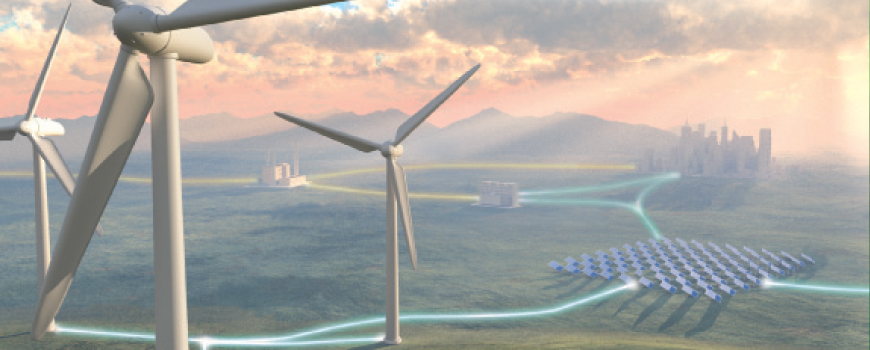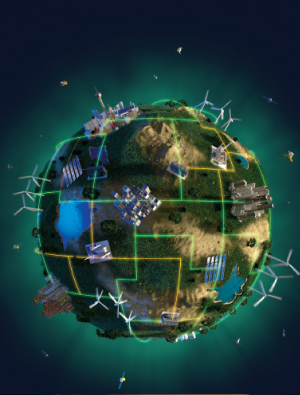
A Complex Challenge
UTSA Pushes to the Forefront of Renewable Energy Research
For all their promise and potential, green sources of energy such as wind power and solar power also are a source of frustration for the people who work to harness them. Wind energy is produced when the wind blows, solar energy, when the sun shines. But air conditioners, heaters, refrigerators, clothes washers and dryers, computers, factory machinery, security alarms, and the whole global array of electrical devices need power delivered on their own terms, not on the whims of nature. Yet there is consensus among business and political leaders that the nation must learn how to utilize these renewable, environmentally friendly sources of energy, like the wind and the sun, and break away from the current dependence on fossil fuels.
That will require energy providers such as San Antonio’s CPS Energy to integrate disparate, sometimes inconsistent, sources of energy into a network that can provide reliable service to residential, industrial and business power consumers. Power must ebb and flow with the peak demand, during the mid-day heat of August as well as the freezing winds of a January night.
UTSA civil and environmental engineering professors are part of that quest. With “green energy” now a national priority, the university has formed the Texas Sustainable Energy Research Institute. Faculty members have a dual mission: They are working on the technology to help the United States develop and integrate its vast sustainable energy sources, and they are also developing educational programs that will attract students to the university and prepare them for jobs of the future.
Training Students to Work with a Smart Grid
Training Students to Work with a Smart Grid As educators, UTSA faculty members want to train students to become the next generation of innovators and business entrepreneurs in a rapidly changing energy field. As professional engineers, they are precision-driven perfectionists, looking for ways to harness unpredictable forces like wind and sunshine.
“We are the ultimate control folks,” says Brian Kelley, Ph.D., assistant professor of electrical and computer engineering at UTSA. “We want to make things very predictable and controlled.”
Work continues on improving the efficiency and lowering the cost of capturing and storing the “free” energy that flows with the wind and sun. But a larger challenge, Kelley says, is integrating all these components with traditional energy generators, such as coaland gas-fired plants, resulting in a system that provides uninterrupted power to utility customers.
The utility company of the future is likely to have multiple fields of solar collection panels, several wind-energy fields and traditional coal- or gas-fired plants, all feeding into the same system. It needs to be self-regulating, with the ability to produce current when the demand is high and store energy when the demand is low.
“One of the key limitations at this point is the concept of networking,” Kelley says. “Improved networking is what we need to do as a country if we want to convert to an electric-power-based economy.”
Power Grid Must Become a Two-Way Street
Kelley leads a project to build and test a system accomplishing that. The goal is to turn the existing power grid into a Smart Grid. The power grid must become a two-way street, he explains, where utility companies like CPS Energy can “talk” with energy users such as hospitals and factories as well as with the solar panels, wind-power fields, storage devices and traditional power plants that all produce current for its system. Who needs power, and who has it? With a Smart Grid, all the components of a utility company can work seamlessly and instantaneously to produce a steady flow of electricity for the power grid. It is a complex challenge, but one that must be solved.
“Utilities need a system that will sense the entire metro area—its needs and the available sources—and integrate all these things,” he says. “If we are going to move toward electrification of our economy, we need our grid to improve. The ‘Smart Grid’ is integral to what we have to do as a country.”
The Smart Grid project is among a wide range of research initiatives at UTSA’s Texas Sustainable Energy Research Institute, which strives to address global energy challenges while advancing the university’s position as a center of innovation in this emerging field.
Les Shephard, Director of the Institute, has assembled research teams that are pursuing issues such as improved renewable resource technology, the electrification of transportation, carbon dioxide recapture and management, and the role of water resources in energy development. There is also a large effort to explore the human factor and develop programs that encourage public participation in resource conservation.
Dr. Brian Kelley came to UTSA in 2007 after extensive experience with wireless network development and testing at Motorola, Inc., in Austin. Now he is the lead scientist on two grants that will use UTSA’s Downtown and 1604 Campuses as Smart Grid test laboratories.
One of his faculty partners in the effort is Hariharan Krishnaswami, Ph.D., an assistant professor who is working on the hardware and software electronics and security components that will go into this complex system. Krishnaswami came to UTSA two years ago from the University of Minnesota, where he developed specialties in designing and building the computer-controlled circuits that run complex electrical production and energy storage systems. Now he is using university support and a grant from CPS Energy to build and assemble a laboratory-sized prototype Smart Grid. An experimental five kilowatt solar panel will be integrated with experimental hardware and software so engineers and students can work out the basic mechanics of their ideas.
“How do we integrate several renewable sources of energy into one system?” Krishnaswami says, stating his research challenge. “Our systems need to become more and more intelligent and capable of making decisions themselves about where to draw power from and where to send it.”
Linking Renewable and Traditional Sources of Energy
This laboratory test bed will allow engineers to develop models and test components of an experimental integrated energy system. Then it will be applied to link a network of renewable and traditional sources on the Downtown and 1604 Campuses.
UTSA has grants from the State Energy Conservation Office (SECO) that are supporting a Clean Technology Incubator, which is bringing state-of-the-art solar energy equipment and sensor networks to facilities at the Downtown and 1604 Campuses. The university will install solar panels which can collect 170 kilowatts of power off the University Center III and Engineering Building on the 1604 Campus and another 125 kilowatts off the roof of the Durango Boulevard garage downtown. Other components of the project include electric-car-charging stations, technology to convert and store solar energy, building sensors and “Smart Meters” that can communicate information back to a central facility. The components will be networked with a command center computer that can make decisions on routing and control to optimize the flow of electricity. “Ideally, we would like to be the incubator campus for the Smart Grid.”
Another key to increasing the availability of renewable energy is developing better ways to capture and store it for the times when the sun doesn’t shine and the wind doesn’t blow.
Sunlight, Kelley says, is the most abundant form of renewable energy on Earth. The sun generates the equivalent of 2.2 gigawatt hours of electricity, and only 1/20th of it is being used.
“Clearly there is enough solar energy in the world to power everything we want to power. The challenge is the cost of converting a free source of energy to a useable source of energy.”
Even the best technology can’t capture all of the sun’s energy, of course. Some of it lands in places that are inaccessible, such as mountaintops and ocean surfaces. Still, the energy industry is not yet making the most of the solar power that is accessible. Sunlight arrives in lumens, which must be converted into electrons to produce current. The technology for accomplishing this still is inefficient, according to Kelley; only 15 to 20 percent of the captured solar lumens are now being converted to electricity-producing electrons. If researchers can improve that efficiency to 40 percent, he says, the cost of solar power will fall low enough that it will be competitive with fossil fuels.
“We are all trying to develop the technological leadership in the ‘Smart Energy’ field to get there.”
Faculty and students at the UTSA Texas Sustainable Energy Research Institute have a number of research projects underway, exploring all the pieces of technology required to increase storage capacity, improve the efficiency of conversion devices and wire the Smart Grid.
Looking at Jobs of the Future
These research projects are training young people for the jobs of the future, says Krishnaswami, who last semester was able to offer a course in power electronics at UTSA for the first time. He also has nine master’s and doctoral students working with him on the architecture and components of the Smart Grid test bed in his laboratory.
Kelley and a student are developing a project to improve large-scale storage of converted electrons from the sun, with the device networked into the Smart Grid. The Department of Energy set a national goal for the United States to have 20 percent of its energy come from renewable “green” sources by 2030, Krishnaswami notes. It is a goal that translates into thousands of jobs for students who learn the right skills.
“If the United States is going to meet that goal, then the amount of solar power and wind energy in use has to increase,” he says. “Utilities will need people who know how to develop these sources and integrate them.”
Industrial and commercial businesses and even homeowners will be looking at using renewable energy sources too, as the technology becomes more efficient and affordable. UTSA’s research and development program should translate into new jobs and a prosperous economic boost for the San Antonio area.
“We need to offer research and education,” Krishnaswami says. “There are a lot of opportunities.” Even though much of it is experimental now, these ideas eventually will graduate, the researchers say. Graduating students will take their ideas and skills from a campus laboratory into the private sector, where start-up companies will design, build, test and market products for large and small power consumers.
Kelley sees big changes coming in the next 50 years, as the world moves from a dependence on fossil fuels to an economy powered by renewable resources. Solar collector dishes will become more common on top of homes, and regional utility providers all will have Smart Grids that integrate various sources of cost-efficient and environmentally friendly renewable energy.
“I really think we are almost on the cusp of a new era. We are in the midst of an energy revolution.”
Les Shephard agrees, and he sees a major role for both the San Antonio region and UTSA in an emerging field that will transform the way people live.
“The university must play a critical role in bringing innovations to these visions,” Shephard says. “We are on a very important journey now. The mission of this institute is about developing citizen leaders who are committed to transforming America’s energy future.”
Error processing SSI file

